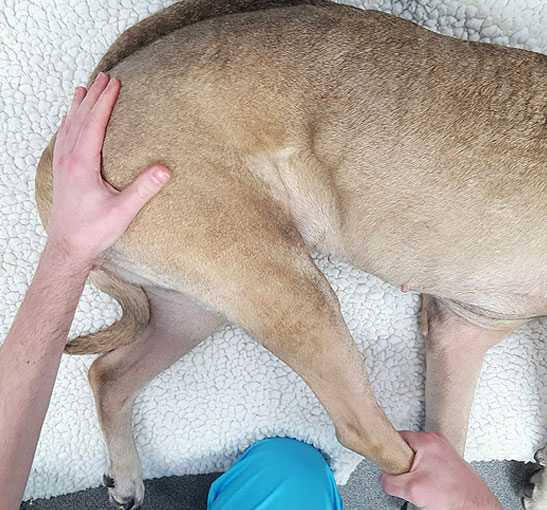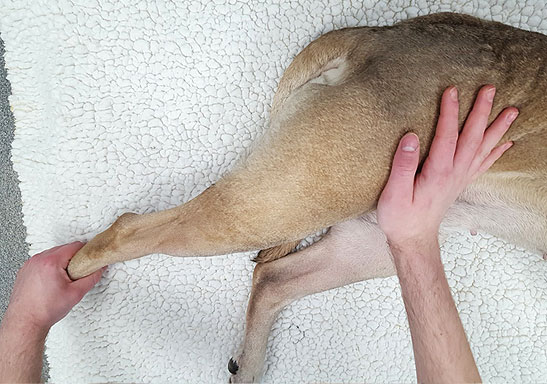
Physiotherapy is dedicated to restoring function to an injured or diseased patient by physical methods such as massage, heat treatment and exercise. It plays a vital role in relieving pain, improving joint and muscle health and aids the rehabilitation of patients after major injury or surgery.
Stretching or passive range-of-motion exercises can be performed as soon as your pet is sufficiently comfortable. These exercises help to reduce joint stiffness and limit muscle wastage (atrophy).
Some animals will prefer to stand and others will prefer to lie when receiving physiotherapy. An extra pair of hands is often helpful to help restrain the patient. Use padded bedding for your pet if performed lying down.
After consultation with a veterinary surgeon, the following exercises can be performed for around 20-30 minutes three to four times daily.
Massage
This should be done before the stretching exercises as it helps the muscles warm up and become more flexible. Support the limb and gently massage it for a few minutes, working from the toes towards the top of the limb. Gradually increase the pressure, especially at the top of the limb where the muscles are larger. This should be enjoyable and help your pet to relax.
Stretching – Passive range of motion exercises
Joint motion encourages circulation and helps maintain joint health. Joints should be manipulated through their full range of motion whilst maintaining reasonable comfort. If at any point your pet becomes restless, painful or yelps, stop the exercise and try again later in the day. Never stretch your pet’s leg too far as this will be extremely uncomfortable for them.
As with the massage you should start at the toes and progress towards the top of the leg.
- Starting with the toes, gently flex or wiggle each toe.
- To flex the knee and hock joints, place your dog’s paw in the palm of your hand and gently push the leg up towards the body until the leg is fully flexed. Hold in place for 5 seconds, relax the leg and repeat up to 5 times.
- To flex the hip joint, gently extend the leg forwards and hold in place for 5 seconds. Relax the leg and extend backwards, holding in place for 5 seconds. Relax the leg then lift it upwards, hold in place for 5 seconds, relax and repeat this up to 5 times.
- The entire limb may now be cycled through its entire range of motion by using the bicycle movement.
- Repeat these steps with the other leg.
Care must be taken to support the spine and prevent unnecessary movement of the spine during any of the exercises.

Flexing the knee and hock joints

Flexing the hip joint

Extending the hip joint

Stretching the hip by lifting the limb upwards
Assisted Standing Exercises
Using a non-slip surface such as a rug, carpet or bath mat, place your pet in a standing position. Ensure all four limbs are in a natural position and the paws are flat on the floor. Support your pet as necessary to prevent them from falling and injuring themselves. Gradually, as the muscles become stronger, less support will be required.
Whilst in the standing position you can bounce your pet gently on their toes and sway them gently from side to side. This encourages them to place their paws correctly on the floor and to build up muscle strength.
Assisted Walking Exercises
Your pet may be taken outside to allow them to toilet and to encourage limb movement. They should be walked slowly and gently, if necessary using a harness and abdominal sling (you can use a scarf or towel) for around five minutes. Ruff wear boots can be placed on the feet when out to prevent sores developing on the paws.

A patient being walked using a harness and abdominal sling
Arranging a referral for your pet
If you would like to refer your pet to see one of our Specialists please visit our Arranging a Referral page.